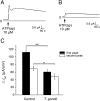Infection by Toxoplasma gondii, a severe parasite in neonates and AIDS patients, causes impaired anion secretion in airway epithelia
- PMID: 25831498
- PMCID: PMC4394305
- DOI: 10.1073/pnas.1503474112
Infection by Toxoplasma gondii, a severe parasite in neonates and AIDS patients, causes impaired anion secretion in airway epithelia
Abstract
The airway epithelia initiate and modulate the inflammatory responses to various pathogens. The cystic fibrosis transmembrane conductance regulator-mediated Cl(-) secretion system plays a key role in mucociliary clearance of inhaled pathogens. We have explored the effects of Toxoplasma gondii, an opportunistic intracellular protozoan parasite, on Cl(-) secretion of the mouse tracheal epithelia. In this study, ATP-induced Cl(-) secretion indicated the presence of a biphasic short-circuit current (Isc) response, which was mediated by a Ca(2+)-activated Cl(-) channel (CaCC) and the cystic fibrosis transmembrane conductance regulator. However, the ATP-evoked Cl(-) secretion in T. gondii-infected mouse tracheal epithelia and the elevation of [Ca(2+)]i in T. gondii-infected human airway epithelial cells were suppressed. Quantitative reverse transcription-PCR revealed that the mRNA expression level of the P2Y2 receptor (P2Y2-R) increased significantly in T. gondii-infected mouse tracheal cells. This revealed the influence that pathological changes in P2Y2-R had on the downstream signal, suggesting that P2Y2-R was involved in the mechanism underlying T. gondii infection in airways. These results link T. gondii infection as well as other pathogen infections to Cl(-) secretion, via P2Y2-R, which may provide new insights for the treatment of pneumonia caused by pathogens including T. gondii.
Keywords: ATP; Cl− secretion; P2Y2 receptor; cystic fibrosis; pneumonia.
Conflict of interest statement
The authors declare no conflict of interest.
Figures





Similar articles
-
Extracellular zinc and ATP restore chloride secretion across cystic fibrosis airway epithelia by triggering calcium entry.J Biol Chem. 2004 Mar 12;279(11):10720-9. doi: 10.1074/jbc.M313391200. Epub 2003 Dec 29. J Biol Chem. 2004. PMID: 14701827
-
Apical and basolateral ATP stimulates tracheal epithelial chloride secretion via multiple purinergic receptors.Am J Physiol. 1996 Jun;270(6 Pt 1):C1611-23. doi: 10.1152/ajpcell.1996.270.6.C1611. Am J Physiol. 1996. PMID: 8764143
-
Differential regulations between adenosine triphosphate (ATP)- and uridine triphosphate-induced Cl(-) secretion in bovine tracheal epithelium. Direct stimulation of P1-like receptor by ATP.Am J Respir Cell Mol Biol. 2001 Sep;25(3):370-6. doi: 10.1165/ajrcmb.25.3.4382. Am J Respir Cell Mol Biol. 2001. PMID: 11588016
-
Adenosine receptors, cystic fibrosis, and airway hydration.Handb Exp Pharmacol. 2009;(193):363-81. doi: 10.1007/978-3-540-89615-9_12. Handb Exp Pharmacol. 2009. PMID: 19639288 Review.
-
Airway epithelial cells--functional links between CFTR and anoctamin dependent Cl- secretion.Int J Biochem Cell Biol. 2012 Nov;44(11):1897-900. doi: 10.1016/j.biocel.2012.06.011. Epub 2012 Jun 16. Int J Biochem Cell Biol. 2012. PMID: 22710346 Review.
Cited by
-
PM2.5 Exposure Inhibits Transepithelial Anion Short-circuit Current by Downregulating P2Y2 Receptor/CFTR Pathway.Int J Med Sci. 2024 Jul 22;21(10):1929-1944. doi: 10.7150/ijms.96777. eCollection 2024. Int J Med Sci. 2024. PMID: 39113893 Free PMC article.
-
Plant-made oral vaccines against human infectious diseases-Are we there yet?Plant Biotechnol J. 2015 Oct;13(8):1056-70. doi: 10.1111/pbi.12471. Epub 2015 Sep 7. Plant Biotechnol J. 2015. PMID: 26387509 Free PMC article. Review.
-
Conjunctival Fluid Secretion Impairment via CaCC-CFTR Dysfunction Is the Key Mechanism in Environmental Dry Eye.Int J Mol Sci. 2022 Nov 19;23(22):14399. doi: 10.3390/ijms232214399. Int J Mol Sci. 2022. PMID: 36430877 Free PMC article.
-
SARS-CoV-2 nucleocapsid protein triggers hyperinflammation via protein-protein interaction-mediated intracellular Cl- accumulation in respiratory epithelium.Signal Transduct Target Ther. 2022 Jul 27;7(1):255. doi: 10.1038/s41392-022-01048-1. Signal Transduct Target Ther. 2022. PMID: 35896532 Free PMC article.
-
CFTR Inhibitors Display Antiviral Activity against Herpes Simplex Virus.Viruses. 2024 Aug 16;16(8):1308. doi: 10.3390/v16081308. Viruses. 2024. PMID: 39205282 Free PMC article.
References
-
- Chan HC, Wang ZD, Yang GQ. Exocrine Physiology: Basic Theories and Clinical Aspects. Science Press; Beijing: 2002.
-
- Spring KR. Epithelial fluid transport—A century of investigation. News Physiol Sci. 1999;14:92–98. - PubMed
-
- Boucher RC. Human airway ion transport. Part one. Am J Respir Crit Care Med. 1994;150(1):271–281. - PubMed
Publication types
MeSH terms
Substances
LinkOut - more resources
Full Text Sources
Other Literature Sources
Miscellaneous

